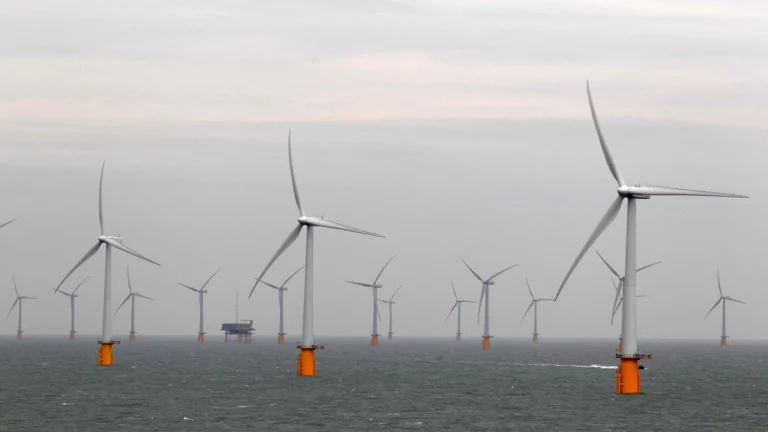To reduce energy expenses to an emotional level, floating wind turbines are essential to the future of offshore wind. The unique pyramid-shaped floating wind turbine developed by the French business Eolink, which promises to significantly lower energy rates and lower materials and load by more than 30%, is now being built on a full-scale prototype. The design put forth by the French company Eolink is one of the few where the most pronounced divergences are visible on the surface.
How does Floating Offshore Wind Function? What is it?
Moving onshore wind turbine installations to shallow coastal seas has been the usual method for constructing offshore wind farms. One of the causes is that offshore winds are more constant and powerful, unlike onshore winds, which encounter impediments like mountains and forests.
Fixing the structures of these wind turbines to the seafloor and making them strong enough to resist the assault of waves are two issues associated with offshore wind generation. The reality that such a structure must be installed restricts its use to the shallow seas of the continental shelf nearest to shore.
By using floating structures attached to the platform by steel or other cables, floating panels, sometimes referred to as Floating Offshore Wind Platforms, can avoid some of these difficulties. These wires stabilize the platform while still having some mobility in mighty waves.
Except for rare installations that utilize two-bladed windmills, the wind turbines employed on the platforms typically have similar traits. The sort of floating platforms used underwater is where there is the most considerable variance. The following variations could be mentioned in this context:
- Spar buoy: The weight is applied at the bottom end of this platform, which has an essential and effective cylindrical base. For it to function effectively, there must be more than 100 meters of depth.
- Barge mode: The platform’s width and length are more akin to a vessel than the previous design.
- Semi-submersible base: It makes use of many semi-submersible cylinders linked together by beams.
- TLP model: For safety, it is supported by a central axis and arms attached to the serpentine belts.
Reasons behind the Previous Model’s Shortcomings
- Whenever it concerns offshore wind turbine, where the majority of the world’s finest wind energy reserves are located, and the conventional fan-on-a-stick pinwheel design employed for onshore wind farms isn’t a better fit. You need to hover your turbines whenever the water is too deep to anchor a massive pole on the ocean floor. You need a vast volume of grounding material at the bottom when you attempt to use a pinwheel structure adopted from land-based innovation. Additionally, due to the physical stress produced by a massive fan on one side of a nacelle, you must run gigantic bearings to support its imposing one-sided weight. They are also challenging to install and costly to maintain.
- In one of the discussions in September with Boston-based startup T-Omega, the firm discussed a unique strategy for a Pyramid wind turbineis anything built from scratch for deep offshore implementation that could significantly reduce the strength, expense, and engineering stress of a massive turbine while making it significantly simpler to deploy and preserve. And although French business Eolink appears to be well on its way to putting a comparable notion into action, T-Omega is still looking for collaborations to get its designs through wave tank research and into commercial use.
New Floating Wind Turbines Design Advantages
- The pinwheel design’s single pole is replaced with a pair of triangles in the pyramid base of this type of design, which is how a Ferris wheel is sustained. The vast weight of the enormous fan is immediately spread equally among the bearings on both sides instead of just one. As a result, the nacelle at the top can be smaller and run with four pyramid-shaped supporters rather than a single, massive pole. As a result of the weight reduction and the creation of a broad base at the bottom instead of a single point, substantially less expensive ballast metal is required to maintain the object’s upright position.
- Since land-based wind turbines must be able to tilt themselves further into the wind to maximize their output, you cannot employ these Ferris wheel pyramid designs. In the deep ocean, that is not an issue; you just attach these drifting pyramids to the bottom. The turbine is blown in the direction of the wind, and because the rope is placed on the front side, it constantly faces the wind’s direction.
- Although the direction of the wind and the ocean currents in the deep ocean are typically aligned, Eolink claims it has developed a dynamic ballast system that can adjust the turbines up to 120 degrees whenever the two are not. To maximize output from the whole wind farm, the operator can redirect the wake left after each turbine, possibly at the cost of some power from the front row of turbines.
Development and Employment: Is it Pricey?
Everything about creating and installing these floating wind turbines is much simpler. They can be constructed in a shipyard and launched directly into the water. It is where they float at shallow depths because they don’t have to carry a lot of ballast below the surface. According to Eolink, a single shipyard should be able to produce 67 turbines annually.
Once constructed, you submerge them in the water, tow them to your location, tie them, connect them, and you’re ready to go. No specialized multi-million dollar per day crane ships is required for installation or maintenance because you can tow them back into port and complete your task there, where it is much simpler and less expensive.
These designs should be affordable at every stage, including engineering, materials, manufacture, and installation, scalability, and lifespan service. These advantages could be of the utmost importance given that the European offshore wind industry is struggling due to growing material costs, supply chain challenges, inflation, and competition from Chinese firms that are starting to expand their global offerings.
The wonderful people at Recharge News report that capital investments by Spain’s Acciona Power and project management company Valorem have enabled Eolink to receive a Final Investment Decision (FID). Eolink is starting to produce a full-scale test turbine that will be installed at the SEM-REV test site in the French Atlantic Ocean now that it is entirely funded to the tune of US$23 million.
The Wind Pyramid: An Innovative Concept
- A 52 m (171 ft.) square foundation and 1,100 tonnes of weight will make up this 5 MW wind turbine. The diameter of the rotor itself will be 143 meters (469 feet). Eolink claims that to achieve the same rated power, its design should utilize more than 30% less steel than a conventional pinwheel. Lengthier and more elastic blades can be mounted for a particular tower height, producing an anticipated 10% more total energy from the same wind patterns. It is possible since the blades don’t have to worry about colliding with the tower. Its development will start this month and should be moored and securely anchored the following (Northern Hemisphere) spring. It will then be put into service in 2024.
- And even better, according to the business, it scales much stronger than pinwheel-style turbines. 5 MW wind turbine specifications aspire to build a massive 20-MW turbine with this design. That would be significantly larger than the largest wind turbine, which is enormous in scale.
- Flexible blades are another way to lessen damage to a wind turbine’s structural integrity. The issue with the nacelle concept is that using too long and flexible blades is not an option because of the danger they pose to the main mast.
- Based on its creators, the “pyramid” of poles, based on its creators, lowers the possibility of collision and permits the use of larger, more elastic blades, thereby improving energy efficiency. This construction also increases strength and enhances weight distribution.
- The innovative floating wind turbines might produce 20 MW per unit with an efficiency 20-25% greater than the current reference solutions when combined with a brand-new platform design with a buoy at a depth of 20 meters. Although the maker is still in the testing phase of this ground-breaking floating offshore wind strategy, the company has plans to build a 5 MW demonstration wind turbine soon.
According to Eolink, these floating wind turbines should deliver electricity at 20 and 25% less than “a reference technology.” So, while T-Omega and more revolutionary alternatives like Massive Global Wind’s vertical-axis dual contra-rotating turbines offer a radical 50% price decrease, these French turbines will be tested on a larger scale much sooner. We are interested in observing how they perform.

















